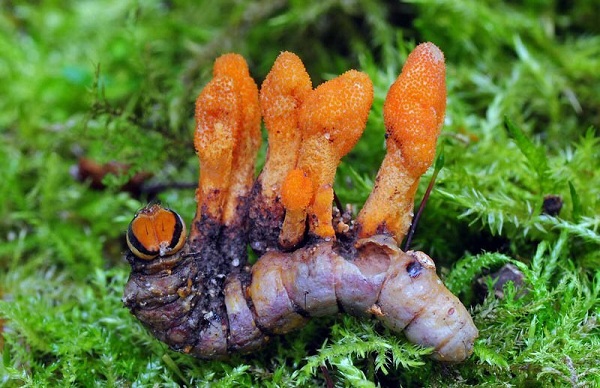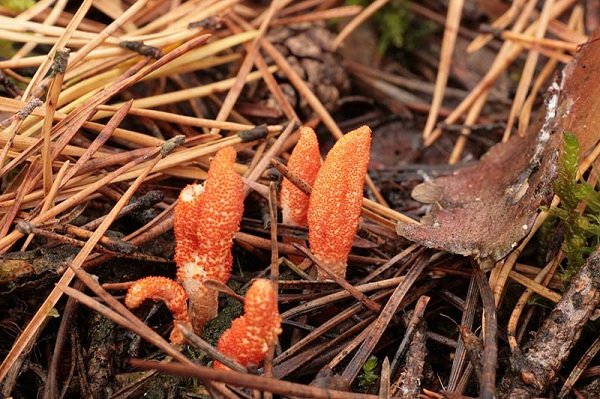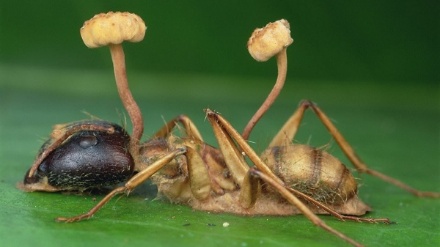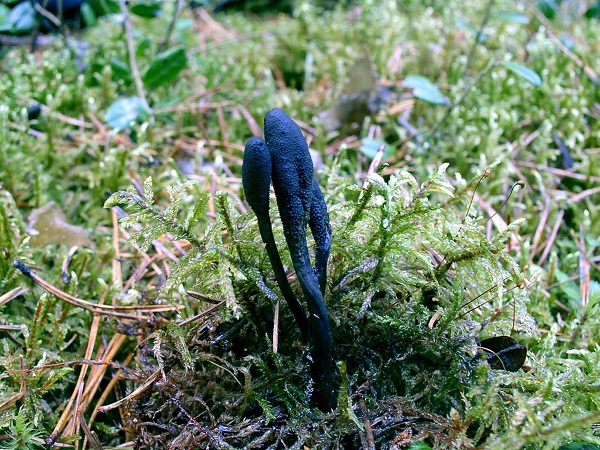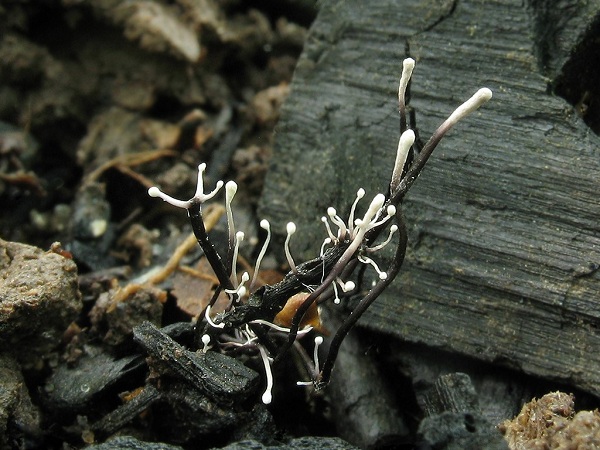Content
Military cordyceps is a common mushroom of the same name, which has no edible value, but is very useful for diseases or the healing of open wounds. In the people and oriental medicine, the mushroom is known as Turrobium or military acid. It does not attract the attention of insects or animals, it is rare for mushroom pickers who bypass it.
What military cordyceps look like
The fungus of an unusual shape belongs to the spore variety of parasitic organisms. The cylindrical curved mycelium stem looks like a whitish or bright orange process. The mushroom has no hat, its color depends on the habitat and the type of insects on whose bodies it grows. The length of the military cordyceps is only 2-8 mm, in rare cases, the growth reaches 8 cm. The surface of the fruiting body is tuberous or vesicular.
In the context of the military cordyceps filled with whitish fibrous pulp. The mushroom is inedible, odorless or tasteless. The military turrobium reproduces by cloisonné and filamentous spores. After maturation, the spores break up into small cylinders, and if there are no insect bodies nearby, the colony dies.
Where do military cordyceps grow
A favorable environment for its development is the larvae of earth and ordinary insects, which could not form or hatch. Most often, mycelium colonies are found on butterfly pupae, which are forgotten into the soil. On earth, cordyceps spores are dormant, but when a favorable environment appears, the fungus comes to life and begins to actively develop. Also, spores can appear on the living body of an insect. After spores get on his back, an instant infection occurs. Gradually, the body begins to deform, become covered with a whitish coating, after which the insect dies and mummifies.
The mycelium first grows inside the pupa's body, then secretes a natural antibiotic, after which the military cordyceps begins to develop outside. The body of the animal serves as a protective cocoon for the parasite from pathogenic microorganisms.
By area, military cordyceps is widespread in Asia, Africa, Central and South America. In Russia, the appearance of the parasitic fungus was noticed in the southern forests of the country and the tundra. For the first time, the mycelium of the parasite was found in the mountains of Tibet, after which it began to be artificially cultivated in China. Fungus spores are not afraid of low or critically high temperatures. It is rarely found on the ground, but at an altitude of 6.5 m in the mountains there are many of its varieties.
Is it possible to eat military cordyceps
The opinion of scientists is divided in terms of determining the edibility of the mushroom.It is harmless to the body, officially recognized as inedible, but in some cases it can help even with a serious illness. Military parasitic cordyceps has a valuable composition:
- enzymes and amino acids;
- antioxidants and coenzymes;
- vitamins B, C, PP, K, E;
- metals of magnesium and iron;
- calcium.
In military Turrobia, tyrizinase is absent, which makes it an edible mushroom. However, it does not contain pepsin, which can accurately determine its edibility. That is why the usefulness factor in food has not yet been determined.
How to distinguish military cordyceps
Cordyceps is similar to poisonous varieties from the family of the same name:
- Cordyceps is one-sided. Mushroom of yellow color, parasitizes on corpses of poisonous beetles. A distinctive feature - it resembles a full-fledged mushroom with a cap; it grows from the body of the victim in a single amount without small brothers.
- Ophioglossous. At the time of death, Turrobius the military turns black, which makes him similar to a poisonous variety of black mycelium. Unlike its edible counterpart, it develops on larvae of caterpillars, has varieties of the truffle type.
- Variety of cordyceps gray-ash parasitic mycelium... Reaches 3-5 cm in height, has no edibility and usefulness for the human body. It develops on any pupae and larvae. It resembles short finger-like processes of black color with a grayish cap.
Medicinal properties of military cordyceps
The main component of the fungus is the natural antibiotic cordycepin. The substance is one of the main powerful elements against tumors. It also reduces, but does not destroy, the activity of dangerous viruses, including HIV and hepatitis. The acid contained in military cordyceps reduces cholesterol levels, normalizes intracranial pressure. Adenosine improves skin condition, prevents the formation of vascular occlusion.
Cordyceps preparations are aimed at preventing or preventing:
- pneumonia, bronchial asthma;
- tuberculosis, pyelonephritis;
- cystitis, uterine bleeding;
- any type of tumor at the initial stage of development.
The daily dosage for an adult is 3-5 g of the substance. Preparations with military cordyceps have only a healing effect on the body. Tinctures made from mycelium powder have similar properties. In case of a serious eating disorder or liver cirrhosis, you can additionally consume 200 ml of tincture per day with the main treatment. It is enough to grind the fruit body into powder, fill it with warm water and leave to brew for 10-12 hours. The drug is consumed an hour before a meal or after a meal.
Conclusion
Military cordyceps is more useful for humans in treatment than in ordinary food. Its medicinal qualities are able to help patients with any severity of the disease. Turrobium is no longer considered a rare member of the parasitic fungus family, but its properties have not yet been fully investigated, so you should be careful when contacting this unusual fungus.
